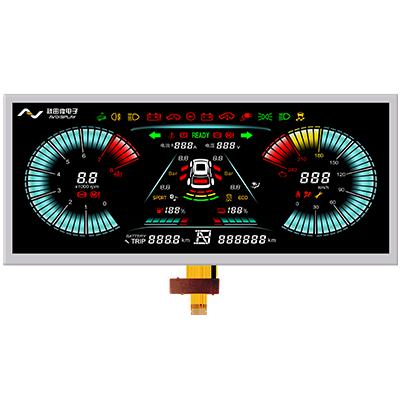Email format error
Email cannot be empty
Email already exists
6-20 characters(letters plus numbers only)
The password is inconsistent
Email format error
Email cannot be empty
Email does not exist
6-20 characters(letters plus numbers only)
The password is inconsistent


As modern vehicles become increasingly reliant on advanced technology, TFT (Thin Film Transistor) displays have emerged as a vital component in automotive systems. From dashboards to infotainment systems and navigation screens, TFT displays offer exceptional visual quality, functionality, and reliability.
This guide will delve into the key considerations for choosing TFT displays for automotive applications, ensuring you select the right solution for your needs.
TFT displays are a type of LCD (Liquid Crystal Display) that uses thin-film transistor technology to control individual pixels. This results in enhanced image quality, faster response times, and better viewing angles. In automotive applications, TFT screens are used for:
Automotive environments expose components to extreme conditions, including temperature fluctuations, vibrations, and exposure to sunlight. When selecting a TFT display:
In a car, a display must remain visible under varying lighting conditions, including direct sunlight.
The resolution and size of a TFT screen significantly affect user experience.
Modern vehicles often use TFT displays with touchscreen functionality. Consider:
Automotive displays must be viewable from different angles, ensuring all passengers can see the screen clearly.
Modern vehicles require TFT screens that support seamless integration with other systems:
Automakers often seek tailored solutions to align with their brand identity:
Energy-efficient TFT displays reduce power consumption, preserving battery life in electric and hybrid vehicles. Look for:
For outdoor or partially exposed displays (e.g., in convertibles):
TFT screens in instrument clusters provide customizable, high-resolution displays of speed, fuel levels, and navigation. Dynamic interfaces allow automakers to adapt the layout based on driving modes.
TFT displays enhance entertainment and navigation experiences, offering touch interfaces, voice controls, and seamless smartphone integration.
Rear-seat passengers can enjoy movies or games on high-resolution TFT screens with vibrant colors and smooth playback.
HUDs project critical information onto the windshield, with TFT screens driving the visuals for speed, navigation, and alerts.
TFT screens offer crisp visuals and intuitive interfaces, improving driver and passenger satisfaction.
Automakers can design unique layouts, themes, and graphics to align with their branding and appeal to specific customer segments.
By integrating navigation, vehicle diagnostics, and alerts into one interface, TFT displays help drivers stay informed without distraction.
While TFT remains dominant, hybrid technologies like OLED-TFT could emerge, combining the durability of TFT with the contrast and flexibility of OLED.
Curved or foldable TFT screens could redefine interior design, offering immersive visuals and adaptive layouts.
AI-driven interfaces with predictive controls and voice recognition could enhance the functionality of TFT screens.
When choosing automotive TFT display suppliers, there are several factors to consider to ensure you are getting the best quality products and services. Here are some tips to help you make the right decision:
7.1 Quality of Products:
Look for suppliers that offer high-quality TFT displays that meet industry standards and have a reputation for reliability and durability.
7.2 Customization Options:
Consider suppliers that offer customization options to meet your specific requirements, such as size, resolution, and interface compatibility.
7.3 Pricing:
Compare prices from different suppliers to ensure you are getting a competitive rate for the quality of products and services offered.
7.4 Technical Support:
Choose a supplier that provides excellent display technology support and assistance, especially during the installation and troubleshooting process.
7.5 Delivery Time:
Check the supplier's delivery timeframes to ensure they can meet your project deadlines and requirements.
7.6 Reputation and Reviews:
Research the supplier's reputation and read reviews from other customers to gauge their reliability and customer satisfaction.
7.7 Warranty and After-Sales Service:
Ensure the supplier offers a warranty on their products and provides after-sales service and support in case of any issues or concerns.
By considering these factors, you can choose the right automotive TFT display supplier that meets your needs and expectations.
TFT displays have become indispensable in modern vehicles, offering reliability, functionality, and aesthetic appeal. When choosing a TFT display for automotive applications, focus on durability, visibility, resolution, and advanced features to meet the unique demands of the automotive environment.
By staying ahead of emerging trends and incorporating tailored solutions, you can ensure your vehicle's TFT displays deliver exceptional performance and user satisfaction.